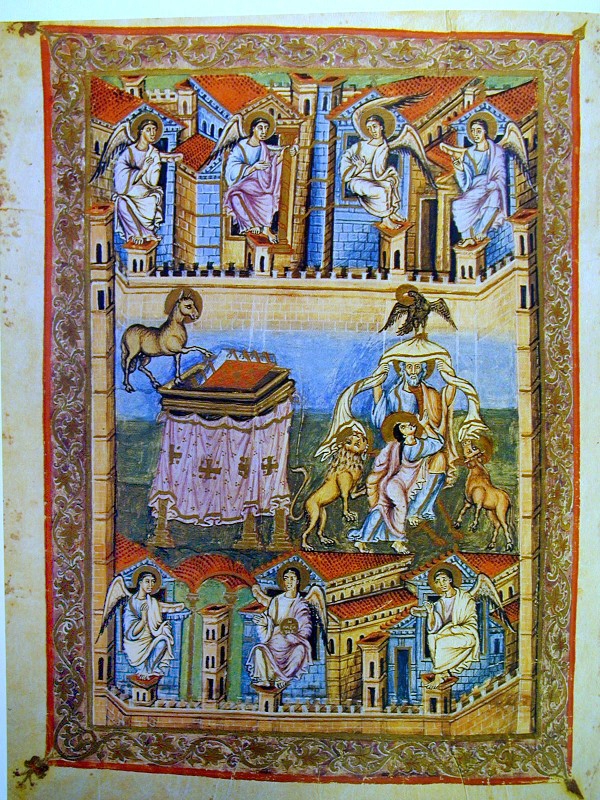The Apocalyptic Vision of Revelation: A Study of Symbolism, Jewish Roots, and Theological Tensions in the Final Book of the Bible
Table of Contents
[[ ]
]
Introduction
The Book of Revelation stands out in the New Testament due to its vivid and complex imagery, apocalyptic themes, and its contrast to the more realistic and ethical teachings of the Synoptic Gospels. As the last book of the Bible, Revelation offers a climactic vision of the final judgment and the establishment of God's eternal kingdom. Yet, the symbolic nature of its language, the multiple Jewish references, and the tension between its apocalyptic vengeance and Jesus' message of forgiveness raise significant theological questions. This essay will attempt to explore these themes with direct reference to the text only. No secodary sources have been consulted.
Jewish Roots and Symbolism
One of the most striking elements of Revelation is its extensive use of Jewish symbolism. Though written to a Christian audience, the text heavily draws on imagery that would be familiar to those versed in Jewish apocalyptic literature. The Ark of the Covenant, mentioned in Revelation 11:19, is one such symbol. The Ark, long absent from Jewish worship by the time Revelation was written, makes a dramatic reappearance in John's vision of the heavenly temple. This suggests a continuity of God's covenant with Israel, pointing to a deeper fulfillment in the person of Christ.
The depiction of the 144,000 sealed from the twelve tribes of Israel (Revelation 7:4-8) also reflects this Jewish foundation. While scholars debate whether this should be interpreted literally or symbolically, the reference to the twelve tribes underscores the continuing role of Israel in God’s eschatological plan. At the same time, the broader vision in Revelation 7:9 of "a great multitude from every nation" widens the scope, revealing the inclusivity of God's salvation, extended to Gentiles.
The Tension Between Judgment and Forgiveness
The tension between *Revelation*’s apocalyptic judgment and Jesus' message of love and forgiveness in the Gospels presents a theological challenge. The vision of Christ in Revelation is markedly different from the compassionate figure seen in the Gospels. In Revelation 19:11-16, Jesus appears as a warrior king, "clothed in a robe dipped in blood," leading the armies of heaven. This image contrasts with the Jesus who taught, "Love your enemies and pray for those who persecute you" (Matthew 5:44).
However, it can be argued that these two depictions are not entirely in conflict. In the Gospels, Jesus does warn of final judgment (Matthew 25:31-46), and his parables frequently speak of separating the righteous from the wicked. Revelation expands on these themes, portraying the ultimate defeat of evil. The violent imagery of God's judgment in Revelation is not necessarily about revenge but rather the destruction of sin and the establishment of justice.
Babylon and Rome: Symbolism of Oppressive Powers
The mention of Babylon in Revelation, particularly in chapters 17 and 18, raises the question of whether this ancient city serves as a symbol for a more contemporary empire , Rome. Babylon, the ancient enemy of Israel, had long been a symbol of exile and oppression in Jewish thought. Its use in Revelation is likely to signify the Roman Empire,under which the persecution of Christians was taking place while John wrote Revelations. His audience were likely fully aware of this and the text can be seen as offering comfort to early Christians.
In Revelation 17:5, Babylon is referred to as "the mother of prostitutes and of the abominations of the earth." This apocalyptic image, steeped in symbolic language, portrays Babylon (and by extension, Rome) as a corrupt and immoral power that will ultimately face divine judgment. The downfall of Babylon in Revelation 18 can be seen as a message of hope to early Christians suffering under Roman persecution, assuring them that God's justice will prevail.
Apocalyptic Imagery and Its Theological Purpose
The surreal and sometimes terrifying imagery in Revelation, such as the locusts with human faces and women’s hair (Revelation 9:7-10), serves not only to terrify but to illustrate the magnitude of divine judgment. These locusts, with their grotesque appearance, symbolise demonic forces unleashed to torment humanity. The use of such vivid imagery heightens the sense of chaos and disorder that accompanies the judgment of God.
This imagery, while unsettling, is part of the apocalyptic tradition. Apocalyptic literature, much like the Book of Daniel, often employs such symbols to convey the spiritual realities behind historical events. The locusts represent not merely a natural disaster but the deeper spiritual consequences of sin and rebellion. Their appearance is intended to evoke fear, as Revelation portrays the ultimate confrontation between good and evil.
Conclusion
The Book of Revelation presents a complex and multi-layered vision of the end times. Its Jewish roots and use of apocalyptic symbolism, combined with its message of judgment, offer a stark contrast to the teachings of love and forgiveness in the Synoptic Gospels. However, when viewed through the lens of divine justice, Revelation can be seen as the necessary final act in the unfolding drama of salvation history. The destruction of evil and the ultimate triumph of God's kingdom fulfill the promises made throughout scripture, bringing the Bible’s narrative to its climactic conclusion.
In this way, Revelation not only connects with Jewish apocalyptic traditions but also extends the hope of salvation to all people, uniting both Jewish and Gentile believers in the promise of a new heaven and a new earth (Revelation 21:1). While its violent imagery and themes of vengeance may seem at odds with Jesus’ earthly teachings, Revelation provides a broader theological framework in which God's justice is fully realized.